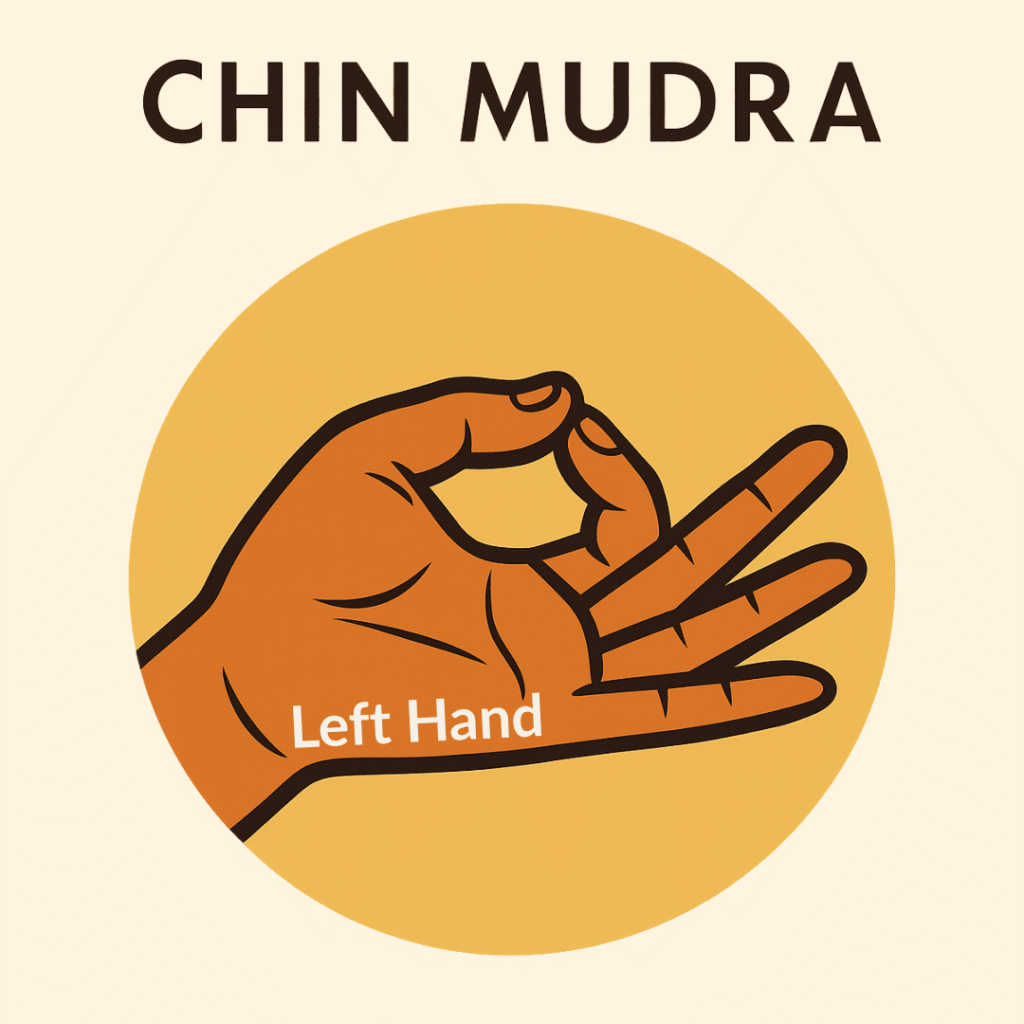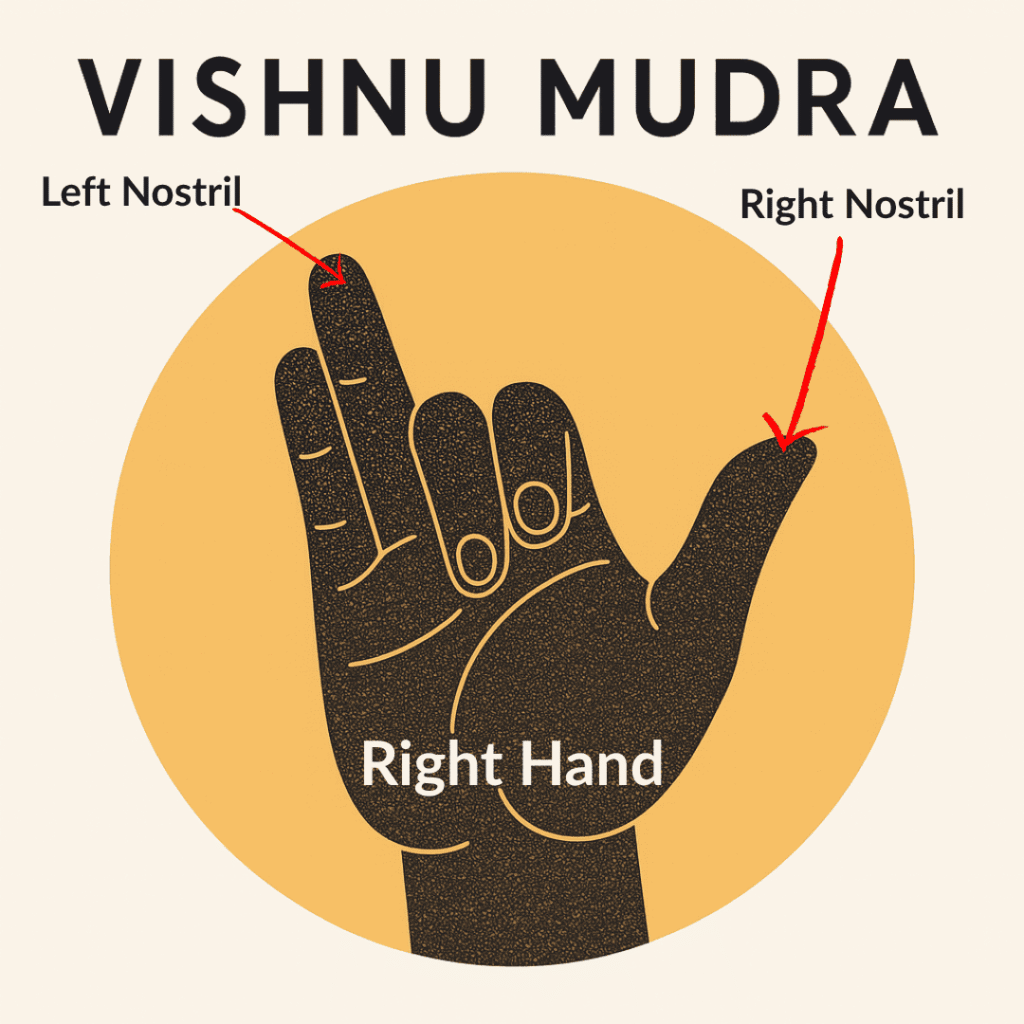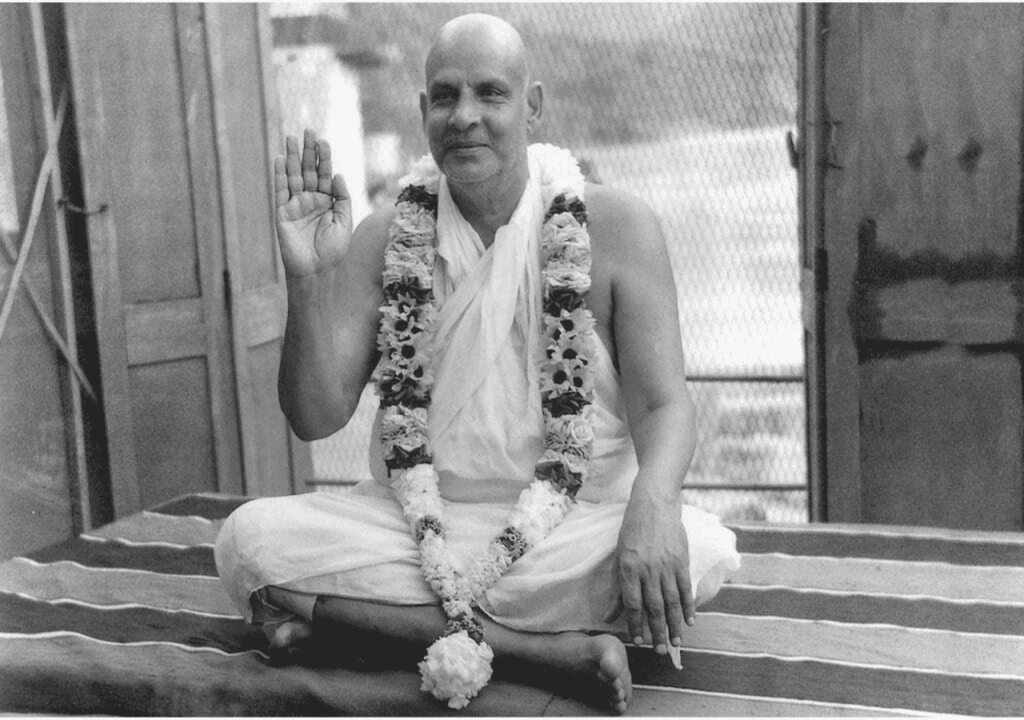How to Do Nadi Shodhana (Properly)
And Why You Don’t Need Any Other Breathing Technique

This post contains affiliate links. If you choose to make a purchase, I may earn a small commission at no extra cost to you. I only recommend products I personally use and trust.
Too many breathing techniques, too little clarity. If you’ve ever wondered how to do Nadi Shodhana properly, you’re not alone.
Modern yoga and wellness spaces are flooded with breathwork tutorials, but a lot of them miss the mark. Rapid-fire methods, stacked exercises and inconsistent guidance often confuse more than they help.
So here’s the question:
What if mastering just one technique was enough?
That’s what this post is about: Going deep into one practice that’s stood the test of time. We’re not chasing variety here. We’re after results. And in my years of study and practice, no technique has offered more stability, clarity, and transformation than Nadi Shodhana.
This post isn’t for people looking for shortcuts. It’s for those who want to go deep, learn it right, and understand what the ancient yogis actually taught. I’ll walk you through the misconceptions, show why this one breathing technique is enough, and teach you exactly how to do Nadi Shodhana properly — step by step.
What Most People Get Wrong About Breathwork
Let’s start with a truth few teachers say out loud:
Most modern breathwork is scattered, superficial, or backwards.
We’ve become obsessed with mixing techniques instead of mastering one. A little Kapalbhati here, a round of Bhastrika there, then straight into alternate nostrils with zero prep. It might feel good short-term, but it misses the deeper purpose of pranayama.
Here’s what’s usually overlooked:
- Breathwork ≠ Pranayama.
Not all breath techniques are pranayama. Classical yoga makes a clear distinction: Kapalbhati, for instance, is a kriya (cleansing technique), not a pranayama practice. True pranayama begins only after certain foundations are in place, and it involves the regulation and suspension of the breath. - Posture and stillness matter.
Without a steady seat and a still body, breath control is unstable. Slouching or fidgeting interrupts the flow of prana and reduces the effectiveness of the practice. - Nasal passages must be clear.
Ancient yogis emphasized neti (nasal cleansing) before breath control. Practicing with congestion or blockages defeats the purpose and leads to strain. - Pranayama isn’t content, it’s discipline.
Somewhere along the way, breathwork became social media content. Flashy clips of quick breathing and bold claims have replaced the sacred, methodical approach laid out in classical texts.
If you’re looking for something simple and beautiful to support your breath practice, I recommend this handcrafted ceramic neti pot. It’s functional, easy to use, and looks great on your bathroom shelf.

How Nadi Shodhana Works And Why It’s All You Need
Nadi Shodhana isn’t just a technique, it’s a complete system in itself. While modern breathwork routines often bounce from one method to another, classical yoga teaches something different. Progress doesn’t come from stacking more practices. It comes from going deeper into one.
Nadi Shodhana, often translated as “alternate nostril breathing,” means purification of the nadis — the subtle energy channels that carry prana throughout the body. When these channels are clear and balanced, the breath flows smoothly, the mind becomes quiet, and the body begins to feel light, calm and energized all at once.
This isn’t just theory. Nadi Shodhana has been given top priority for centuries across multiple classical texts. It’s the bridge between basic breath awareness and the more advanced stages of pranayama. Instead of stimulating or cleansing like some other methods, Nadi Shodhana restores equilibrium. It balances the left and right channels — ida and pingala — and eventually allows energy to flow through sushumna, the central channel that supports deep meditation and higher awareness.
Anulom Vilom, a commonly taught variation, is often used as a stepping stone. It involves alternate nostril breathing without breath retention. It helps develop rhythm and focus, but it’s only the beginning. Nadi Shodhana, in its proper form, includes breath holds (kumbhaka) and precise ratios that move the practice from mechanical to transformational.
“I’ve broken down the subtle science behind this practice more deeply in this post on decoding Nadi Shodhana.”
The truth is, most people never need more than this. Mastering Nadi Shodhana alone — with consistency and correct technique — can purify the nadis, sharpen the mind, regulate emotions, and prepare the inner body for meditation. When done properly and regularly, it becomes both the path and the destination.
You don’t need dozens of breathing styles. You just need one that actually works — and Nadi Shodhana, practiced with sincerity and patience, is that practice.
The Pranayama Progression: A Simple Path
Classical yoga never rushes the breath. There’s a natural order to pranayama, one that builds awareness, strength, and subtle control over time. If you skip steps, the practice becomes forced or superficial. But if you follow the path, each phase prepares you for the next, and it all funnels into Nadi Shodhana as the centerpiece.
Step 1: Deep Abdominal Breathing
Before anything else, learn to breathe well. Most people breathe high and shallow, using only a fraction of their lung capacity. Begin by sitting still and breathing slowly into the belly, allowing the lower ribs and abdomen to expand on the inhale and gently contract on the exhale. This foundational breath helps calm the nervous system and builds awareness of how breath moves through the body.
Step 2: Anulom Vilom (Basic Alternate Nostril Breathing)
Once the breath becomes smooth and steady, you can begin alternate nostril breathing without breath retention. Anulom Vilom trains rhythm and focus. It’s often the first structured technique students learn, and it’s a valuable warm-up for Nadi Shodhana. Inhale through one nostril, exhale through the other, then switch sides and continue the pattern. The breath stays soft and unforced. This step alone can begin to balance the nervous system and shift the mind toward calmness.
Step 3: Kapalabhati (A Cleansing Kriya, Not a Pranayama)
Contrary to how it’s often taught in modern classes, Kapalabhati is not a breathing exercise meant to relax you. It’s a kriya — a cleansing technique — designed to flush the lungs, clear the sinuses, and stir prana through rapid, forceful exhalations. It can be practiced before pranayama to stimulate and purify, but it isn’t a substitute for deeper breath regulation. And it’s not for everyone; it should be learned slowly, ideally under guidance, and skipped entirely if you’re working with certain conditions, like high blood pressure.
Step 4: Nadi Shodhana (The Core Practice)
Once the breath is steady and the channels are open, Nadi Shodhana becomes the main event. This is where breath control begins in earnest. With retention and specific ratios, the breath becomes a tool for subtle inner work — bringing balance to the energy, stillness to the mind, and readiness to the body. Everything up to this point has been preparation for this one practice.
If you understand this progression, you don’t need to second-guess your path. You’re not missing out by skipping trendy techniques or layering in more. You’re doing it the way it’s been done for centuries: slowly, intentionally, and in alignment with how the breath is meant to evolve.
How to Do Nadi Shodhana Properly: Step-by-Step Instructions
This is where depth meets discipline. Nadi Shodhana is more than just breathing through alternate nostrils; it’s a precise practice with structure, intention, and rhythm. When done correctly, it becomes one of the most powerful tools for inner balance and mental clarity. Here’s how to do it properly, just as laid out in the classical texts.
Posture
Sit in a comfortable and steady position (Padmasana, Siddhasana, or Sukhasana are ideal). Keep your spine upright, shoulders relaxed, and head level. If sitting on the floor isn’t accessible, sit on a cushion or in a straight-backed chair with both feet on the ground.


Hand Mudra
Use Vishnu Mudra with your right hand:
- Fold your index and middle fingers down toward the palm
- Use your thumb to close the right nostril
- Use your ring finger to close the left nostril
Place your left hand on your knee in Chin Mudra (thumb and index finger gently touching, palm facing up).
Basic Sequence
Here’s the step-by-step rhythm for beginners:
- Close your right nostril with your thumb
- Inhale slowly through the left nostril
- Close your left nostril with your ring finger
- Exhale through the right nostril
- Inhale through the right nostril
- Close the right nostril again and exhale through the left.
That’s one full round. Continue in this pattern for 6 to 12 rounds, breathing softly and without strain. Keep the breath even and silent, letting it glide in and out without force.
Breath Ratios
Start with a simple 1:1 ratio — equal length inhale and exhale. Once this becomes easy and steady, you can move to a 1:2 ratio, where the exhale is twice as long as the inhale. This helps activate the parasympathetic nervous system and settle the mind.
As your practice matures, you may progress to more advanced ratios like 1:4:2 (inhale, hold, exhale) or 1:2:2, but never force breath retention. These should only be explored gradually and ideally with proper guidance.
Duration and Consistency
Start with 5 to 10 minutes a day, ideally at sunrise or sunset. Once you feel confident and stable, extend the practice to 15–20 minutes, or more if your schedule allows.
The key is consistency. Practicing at the same time each day in the same quiet space builds rhythm, familiarity, and subtle strength in the breath.
What to Avoid
- Don’t practice on a full stomach. Wait at least 3 hours after a meal.
- Avoid strain, force, or breath-holding beyond your capacity.
- Don’t slouch or let your spine collapse. Alignment matters.
- Don’t rush. This isn’t a workout, it’s inner engineering.
Once you establish this daily rhythm, the breath begins to shift. Your energy smooths out. Your mind quiets down. The mental chatter and outside noise begin to fade. And all of that starts with one clear practice, done well and with steady care. Over time, the practice begins to reveal itself.

Swami Sivananda’s Guidance on how to do Nadi Shodhana
Swami Sivananda was an expert on the topic of pranayama. His writings reflect decades of disciplined practice, and his book The Science of Pranayama remains one of the clearest classical resources available. His advice strips away the guesswork and gives real numbers, clear timelines, and grounded expectations. Here’s what he emphasized for those committed to serious practice.
Daily Practice Schedule
Sivananda recommends practicing at least twice a day, preferably at 4:00 AM and 4:00 PM. These times align with the natural stillness of dawn and dusk, which supports deeper internal focus. Beginners can start with 10–15 minutes per session, gradually extending to 30 minutes or more as the breath becomes steady and the body adjusts.
How Long to Practice for Nadi Purification
Classical texts and Sivananda both agree: three months of consistent practice is enough to begin purifying the nadis. This assumes a daily routine of alternate nostril breathing with proper technique and increasing retention over time. After this period, you should start noticing signs of progress, such as a lighter body, clearer thoughts, stronger digestion, and more stable energy throughout the day.
But purification isn’t the finish line. It’s the doorway to deeper states of concentration and meditation. Sivananda makes it clear that true progress only comes through patience, consistency, and faith in the process.
Discipline Over Intensity
The emphasis isn’t on pushing for maximum breath retention or cramming in complex ratios. Instead, Sivananda teaches regularity over intensity. It’s better to show up every day and practice calmly than to force long holds or stack multiple techniques. He repeatedly reminds students that pranayama is not a competition. It’s a purification process that takes time and consistency.
Dietary Guidelines
To support pranayama, Sivananda advocates a sattvic diet — light, pure, and digestible foods. This includes fresh fruits, vegetables, soaked nuts, milk, ghee, and simple grains like rice. Spices, garlic, onions, alcohol, caffeine, and all heavy or greasy foods should be minimized or avoided altogether.
He even suggests that milk and fruit alone can sustain a yogi during periods of intense breathwork. These foods build ojas (vital energy), are easy on digestion, and help keep the body cool and stable.
Other Lifestyle Notes
- Celibacy or sexual moderation is strongly encouraged, especially during periods of intense practice.
- Mental purity is just as important as physical cleanliness. Anger, fear, jealousy, and anxiety all disturb the flow of prana.
- A calm, humble mindset is essential. Sivananda encourages students to approach the practice with reverence, humility, and a quiet mind — not ego.
Ultimately, Swami Sivananda’s approach is practical and direct: show up every day, keep your body clean and light, focus on one practice, and stay patient. That’s what leads to real inner change. It doesn’t come from chasing more techniques, but from committing fully to one that works.
There’s a saying: If you chase two rabbits, you’ll catch none.

Why Simplicity Wins
In the age of endless options, it’s tempting to think more is better: more techniques, more tools, more variation. But yoga doesn’t work that way. Especially when it comes to pranayama, simplicity is what creates stability. Mastery comes from repetition, not variety.
There’s a quiet strength that builds when you stick with one practice. The breath becomes familiar. The mind learns the rhythm. Subtle layers start to reveal themselves, things you’d never notice if you kept switching approaches all the time.
I’ve gone through this myself. Early on, I tried to learn everything at once — bellows breathing, humming breath, cooling breath, rapid breath, breath holds, even the Wim Hof Method. It felt stimulating at first, but ultimately left me scattered. It took time to realize that real growth doesn’t come from mixing more ingredients into the pot: It comes from letting the same one simmer until it transforms you.
Nadi Shodhana has been that ingredient for me. When Practiced daily with intention, it recalibrates everything: your thoughts, your emotions, your nervous system, your sense of space and energy. The more you return to it, the deeper it takes you.
This kind of simplicity doesn’t mean doing less: It means doing something well.
So if you’ve been bouncing between breathwork styles or wondering what’s missing, consider this: maybe you don’t need a new method. Maybe you just need to commit to one that’s already proven, already complete, and already waiting to show you what it can really do. If you’re interested in how modern yoga has often strayed from these deeper roots, you might also like this piece on yoga and cultural appropriation, where I explore how classical teachings are often misunderstood or repackaged.
Final Thought
If there’s one message to take from all of this, it’s that you don’t need to keep searching. Nadi Shodhana offers everything you need. It’s not trendy. It’s authentic. And when you practice it properly, it becomes a foundation that supports every other aspect of your life.
This isn’t about mastering dozens of techniques. It’s about going deeper with one. Give yourself the time to learn it, the space to grow with it, and the consistency to let it work. That’s how the real transformation happens. Not through force, but through consistency and presence.
Have a question or insight about your own breath practice? Drop a comment below, I’d love to hear it.
Want the Full Classical Guide?
If you’re ready to go deeper, I’ve put together a complete resource for the serious yogi based on everything the classical texts teach. From Swami Sivananda’s protocols to yogic dietary principles, kriyas, timing, and the real timeline for purifying the nadis.
